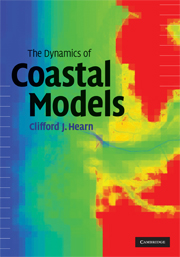Book contents
- Frontmatter
- Contents
- Preface
- Acknowledgements
- Note on mathematics and model codes
- 1 Prelude to modeling coastal basins
- 2 Currents and continuity
- 3 Box and one-dimensional models
- 4 Basic hydrodynamics
- 5 Simple hydrodynamic models
- 6 Modeling tides and long waves in coastal basins
- 7 Mixing in coastal basins
- 8 Advection of momentum
- 9 Aspects of stratification
- 10 Dynamics of partially mixed basins
- 11 Roughness in coastal basins
- 12 Wave and sediment dynamics
- References
- Index
- References
8 - Advection of momentum
Published online by Cambridge University Press: 18 December 2009
- Frontmatter
- Contents
- Preface
- Acknowledgements
- Note on mathematics and model codes
- 1 Prelude to modeling coastal basins
- 2 Currents and continuity
- 3 Box and one-dimensional models
- 4 Basic hydrodynamics
- 5 Simple hydrodynamic models
- 6 Modeling tides and long waves in coastal basins
- 7 Mixing in coastal basins
- 8 Advection of momentum
- 9 Aspects of stratification
- 10 Dynamics of partially mixed basins
- 11 Roughness in coastal basins
- 12 Wave and sediment dynamics
- References
- Index
- References
Summary
Introduction
This chapter discusses some of the basic ideas behind our modeling of advection in coastal basins. We have mentioned advection in previous chapters, but not yet considered any of the unique properties of advection. The word advection simply means the transport of some property of the water column or material from one point in a coastal basin to another. As such, all advection requires a current (and we speak of currents as advecting material). In the flux of any quantity in a coastal basin there are two terms, one due to advection, i.e., current, and the other due to diffusion or dispersion. So, when we have found the current, or advective velocity (u, v, w), we have solved the advective problem to the best of our ability (provided that we do not neglect certain terms in the momentum equation that arise from the advection of momentum). The advection of quantities such as salt is naturally taken into account by the continuity equation for salt by merely expressing the salt flux in the way which we done in previous chapters. So, this chapter is concerned with the advection of momentum and the momentum continuity equation.
Let us consider a one-dimensional system, so that the mathematics look simpler (although there is really no difference for a three-dimensional system). If the component of current is u, then (ignoring diffusion) the flux density of any quantity described by concentration c is uc.
- Type
- Chapter
- Information
- The Dynamics of Coastal Models , pp. 286 - 319Publisher: Cambridge University PressPrint publication year: 2008



